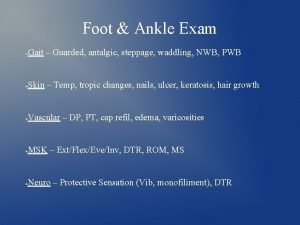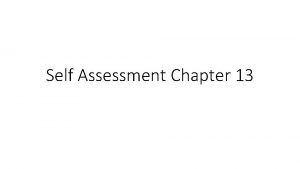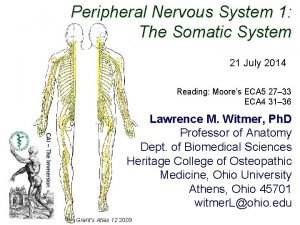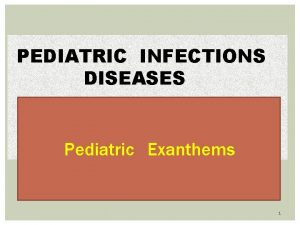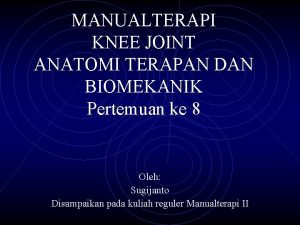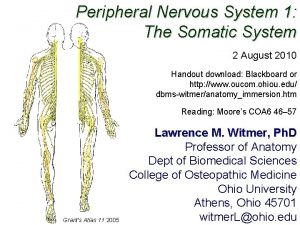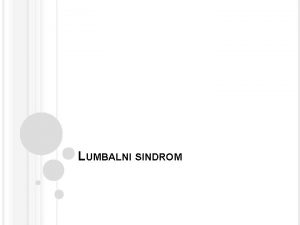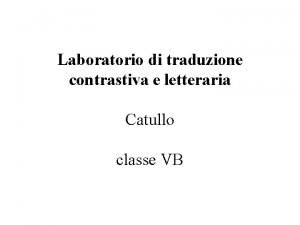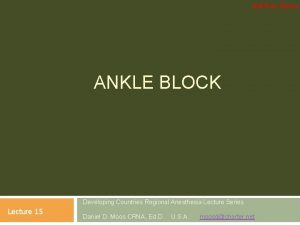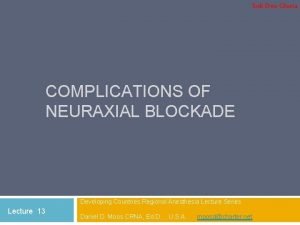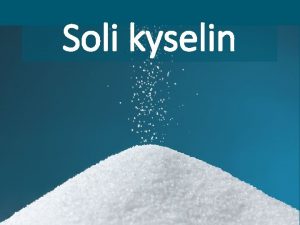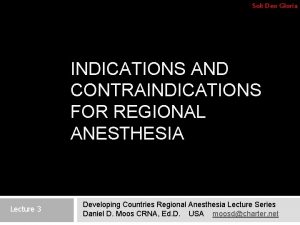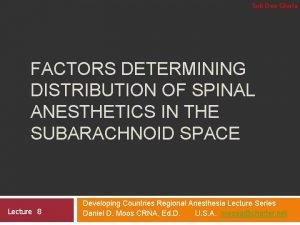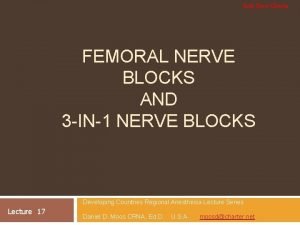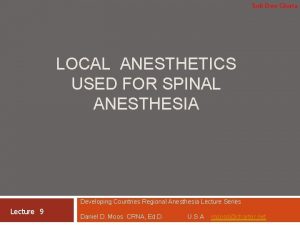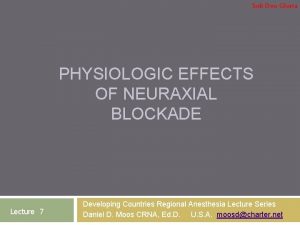Soli Deo Gloria DERMATOME LEVELS Lecture 6 Developing

























- Slides: 25

Soli Deo Gloria DERMATOME LEVELS Lecture 6 Developing Countries Regional Anesthesia Lecture Series Daniel D. Moos CRNA, Ed. D. U. S. A. moosd@charter. net

Disclaimer Every effort was made to ensure that material and information contained in this presentation are correct and up-to-date. The author can not accept liability/responsibility from errors that may occur from the use of this information. It is up to each clinician to ensure that they provide safe anesthetic care to their patients.

Dermatome Level Assessing the dermatome level after neuraxial blockade helps to determine if the block is adequate for the proposed surgical procedure. Differential blockade plays a role in your assessment of blockade height.

Differential Blockade-the why? Injection of local anesthetic will reach spinal nerve roots Blockade of nerve impulse transmission occurs Spinal nerve roots contain several nerve fiber types and classifications- some are more susceptible to local anesthetics than others

Differential Blockade-Local Anesthetic Factors As local anesthetic spreads you see a smaller concentration of local anesthetic at sites distal to the injection Local anesthetic concentration and duration of contact plays a role Susceptibility of nerve fiber types to be blocked

Differential Blockade-Anatomic Factors Small mylelinated fibers are more susceptible to blockade Large unmyelinated fibers are less susceptible to blockade Thus there is a difference between the sympathetic level, sensory level, and motor levels

How Big of a Difference? The sympathetic level is generally 2 -6 levels higher than the sensory level. The sensory level is generally 2 levels higher than the motor level

Testing Levels-Sympathetic An alcohol wipe can be used to test the level of sympathetic blockade. You are testing the patients ability to differentiate differences in skin temperature discernment

Testing Levels-Sensory Level Use a blunt needle that is sharp enough to produce a “pin prick” sensation but not sharp enough to break the skin (i. e. spinal needle stylet)

Dermatome Levels


Common operative sites and minimum level of blockade


Why are the levels for surgery higher than the area of incision and operation? Afferent autonomic nerves! Innervations for visceral sensations and viserosomatic reflexes occur at spinal segments that are much higher than the skin dermatome level of the proposed surgical procedure

Surface Anatomical Landmarks, Dermatome level, and Systemic Effects Important to know so you can assess if the block is adequate Important to know to anticipate systemic effects and potential complications Assessment of inadequate block will allow you to employ an alternative anesthetic technique before incision


T 10 Level (umbilicus) A T 10 Level should provide adequate anesthesia for procedures including: Hip surgery Vaginal/uterine surgery Bladder/prostate surgery A T 12 Level should provide adequate anesthesia for procedures including: Lower extremity surgery without a tourniquet

T 4 Level (nipple) T 4 Level provides adequate anesthesia for intra-abdominal procedures. T 6 Level (Xiphoid Process) provides adequate anesthesia for lower intraabdominal procedures.

C 8 Level (little finger) A C 8 Level is too high. Most likely you have blocked the cardioaccelerator fibers, the patient is hypotensive and may arrest.

Where is T 5? A survey of anaesthetists. T 5 is found between T 4 (nipple level) and T 6 (xiphoid process) Pain during C-section a common cause of malpractice suits in England. 73 anaesthetists (consultants and trainees) were asked to identify T 5 on an anatomical torso model of a non pregnant female. K Congreve, I Gardner, C Laxton, M Scrutton. Where is T 5? A survey of anaesthetists. Anaesthesia, pp. 453 -455. 61, 2006.

Where is T 5? A survey of anaesthetists. Purposely used a “non-pregnant” model to prevent landmarks that may be disguised by the physical changes that occur. K Congreve, I Gardner, C Laxton, M Scrutton. Where is T 5? A survey of anaesthetists. Anaesthesia, pp. 453 -455. 61, 2006.

Results 1 out of 7 were 2 or more dermatomes away from T 5. Anesthesia providers that “believe” that T 5 is higher than where it is actually at may encounter more cardiovascular instability due to blockade of the cardio-accelerator fibers (T 1 -T 4). K Congreve, I Gardner, C Laxton, M Scrutton. Where is T 5? A survey of anaesthetists. Anaesthesia, pp. 453 -455. 61, 2006.

Results Anesthesia providers who “believe” that T 5 is lower than where it is may be left with an inadequate block resulting in pain and conversion to general anesthesia. K Congreve, I Gardner, C Laxton, M Scrutton. Where is T 5? A survey of anaesthetists. Anaesthesia, pp. 453 -455. 61, 2006.

Take Home Message Knowledge of “where” the dermatomes are located anatomically are essential and foundational in testing neuraxial blockade. K Congreve, I Gardner, C Laxton, M Scrutton. Where is T 5? A survey of anaesthetists. Anaesthesia, pp. 453 -455. 61, 2006.

References Brown, D. L. (2005). Spinal, epidural, and caudal anesthesia. In R. D. Miller’s Anesthesia, 6 th edition. Philadelphia: Elsevier Churchill Livingstone. Burkard J, Lee Olson R. , Vacchiano CA. (2005) Regional Anesthesia. In JJ Nagelhout & KL Zaglaniczny (eds) Nurse Anesthesia 3 rd edition. Pages 977 -1030. Congreve K, Gardner I, Laxton C, Scrutton M. (2006) Where is T 5? A survey of anaesthetists. Anaesthesia, pp. 453 -455. Kleinman, W. & Mikhail, M. (2006). Spinal, epidural, & caudal blocks. In G. E. Morgan et al Clinical Anesthesiology, 4 th edition. New York: Lange Medical Books. Warren, D. T. & Liu, S. S. (2008). Neuraxial Anesthesia. In D. E. Longnecker et al (eds) Anesthesiology. New York: Mc. Graw-Hill Medical.
 Gloria gloria gloria aleluia a deus nos altos ceus
Gloria gloria gloria aleluia a deus nos altos ceus Nipple level dermatome
Nipple level dermatome Cantemos glória glória a deus nas alturas
Cantemos glória glória a deus nas alturas Gloria gloria corona de la patria
Gloria gloria corona de la patria Kristalizacija pokus
Kristalizacija pokus Dermatomes
Dermatomes Dorsal foot dermatome
Dorsal foot dermatome Classification of sensory receptors
Classification of sensory receptors Dermatome map
Dermatome map Muscles of upper limb
Muscles of upper limb Th.
Th. Dermatome map
Dermatome map Dermatome
Dermatome Patella dermatome
Patella dermatome Pns
Pns 01:640:244 lecture notes - lecture 15: plat, idah, farad
01:640:244 lecture notes - lecture 15: plat, idah, farad Reganove vežbe za kičmu
Reganove vežbe za kičmu Nui deo
Nui deo Amritdhara pharmacy v. satyadeo gupta
Amritdhara pharmacy v. satyadeo gupta Catullo odi et amo
Catullo odi et amo Uračunavanje poklona u nasledni deo
Uračunavanje poklona u nasledni deo Ille mi par esse deo videtur saffo
Ille mi par esse deo videtur saffo Isključenje nužnih nasljednika
Isključenje nužnih nasljednika Pad napona
Pad napona Deo florida
Deo florida Bilabijalni glasovi
Bilabijalni glasovi






